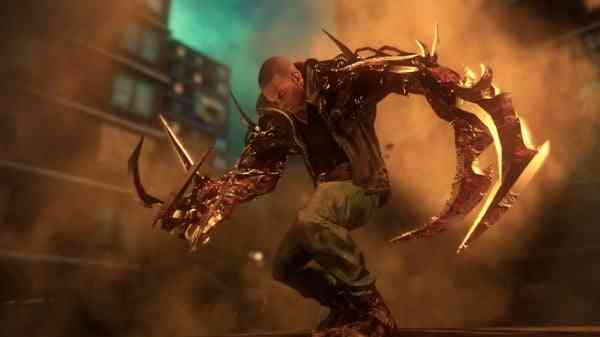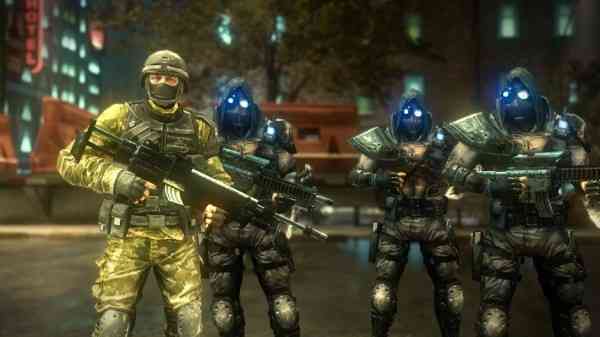Q1: The first PROTOTYPE game features some stunning animations. What visual enhancements can we expect this time around?
MA: Enhancing the game’s visuals has been one of our key goals for PROTOTYPE 2, so you can expect a lot of improvements. Our engine coders have actually rebuilt our entire rendering tech from scratch for PROTOTYPE 2 and Chris Sjoholm, our new Senior Art Director, has brought an incredible vision and eye to detail. Along with an amazingly talented new group of programmers, artists and animators, these changes have resulted in enormous visual improvements in all areas ranging from characters, moves, enemies and effects to cinematics, interface and menus. I think players are going to be really surprised and excited by the level of visual quality that PROTOTYPE 2 is providing this time around.
Q2: Given the size and scope of PROTOTYPE 2, what did not get included in the game that you wanted included?
MA: Good question. We actually managed to get pretty everything we planned for into the final game, but there are always one or two things that don’t make the cut. Personally, I would have loved to see a flamethrower in the game. We talked about this a lot at the start of the project but we quickly started to realise that it was going to be a surprisingly massive challenge. To quote our Senior Technical Director, “If you really want a flamethrower, then PROTOTYPE 2 is going to have to be the game about fire and you’re going to have to forget about a lot of the other features you want to have”. In the end, the cost was just too great.
Q3: What were some of the issues from the original PROTOTYPE game that have been addressed in PROTOTYPE 2? How much of this was based on fan input and how much was based on developer experience from the first game?
MA: A large number of criticisms about the first game that have been addressed in PROTOTYPE 2. When we began work on the sequel, the first thing we did was read every review and piece of feedback we could lay our hands on. We looked at games magazines, websites, blogs and forums and both Radical and Activision did postmortems on the game to figure out what worked and what didn’t. It was the combination of this enormous volume of feedback that formed the basis of the design of PROTOTYPE 2.
Q4: What improvements have been made to the combat system? Why the attention of “tendrils”? Were there any other types of combat skills or features that you considered but did not implement?
MA: We’ve made a lot of changes to the combat system. Many of them are “under the hood” changes that players may not immediately notice, but the end result is a combat system that feels really tight and allows the player to be totally in control in even the most chaotic of battles. One of the most obvious changes that fans of the original game will notice is the addition of “dual-wielding”. This has opened up some really interesting combinations such as using a Hammerfist Slam to launch enemies into the air and then following up with a Blade Slice that cuts them in two while they’re still in midair.
As for the Tendrils, we really wanted to add an iconic new power that was persistent in the environment. The goal was that the player could finish a massive battle and then look around at all of the destroyed vehicles and dismembered bad guys strung up around the scene and say to themselves – “Yeah! That was ME!”
Q5: Being a Vancouver based company, did you experience any limitations due to the studio’s location or accessibility to resources?
MA: No, not at all. It was actually quite the opposite. Vancouver has been one of the world’s key centers for videogame development over the last decade or so. Unfortunately, many of the companies in the city have been victims of the ongoing recession and been forced to downsize or close. We’ve been extremely lucky at Radical in that these events have actually allowed us to add some incredibly talented people to our team.
Q6: PROTOTYPE was an open world game. Is there a particular reason why you wanted PROTOTYPE 2 to remain open world and not turn to a linear mission based game?
MA: I think the nature of your abilities as a Prototype pretty much demand that the game is open world. It would horrible to have such amazing extreme parkour abilities and be locked into a linear environment. It also helps that Radical specializes in open world games and we’re all huge fans of the genre.
Q7: What can fans of the previous PROTOTYPE game expect this time around? What are you hoping to provide fans of the original while at the same time being able to attract new fans who are not familiar with the original?
MA: Our goal has been to deliver a really slick, polished, well-presented game with a strong story, well-crafted missions and really well tuned core mechanics. Fans of the original are going to find that we’ve taken everything they loved about the first game and really expanded and tightened it up. People that are new to the series will discover an incredibly fun and rewarding open world experience that’s very different to anything they’ve ever played before.
Q8: Ballpark, how long can we expect the single player campaign to take? Is there a difference for those who just ‘race’ through the missions/story and those that are considered “completionists”?
MA: Completion times vary dramatically based on skill level and the type of player. The main campaign is comfortably around the 20 hour mark and there’s a huge amount of side content to keep players engaged outside of the central story.
Q9: Fans of ___________ will enjoy Prototype 2?
MA: “awesome, chaotic, completely over-the-top superhuman shapeshifting open world action” or, as I like to call it, “fun”.
Q10: What enhancements can we expect in the sound department? How much voice work went into the game (e.g. recording, voice sessions, number of voice actors, etc)?
MA: One of the major things that we did in terms of the voice work was ensuring that all of the actors were in the studio at the same time. It sounds kind of obvious, but it’s actually difficult to pull off because the different demands on the actors’ time. By making this work, however, we’ve ended up with performances where all of the conversations and interactions come off as very natural and convincing.
The other thing that I’ve been really pleased with is the original score by our Sound Director, Scott Morgan. He’s done an incredible job of delivering an extremely memorable and iconic soundtrack that everyone on the team has been really impressed by. I’ve been amazed at how many times someone has stopped to comment on how much they like a certain piece of music during a mission or gameplay review. I think that says a lot.
**********************************************************************************************
Special thanks to Matt Armstrong and the rest of the PROTOTYPE 2 team for taking the time out to answer our questions.
About Matt Armstrong, Design Director, Radical Entertainment
Matt Armstrong began his career in the video game industry over 13 years ago working on the seminal classic Final Fantasy 7…as a QA Tester. A few short weeks of this was enough to convince Matt that his future lay more in the creative arts, and he soon found himself working as a 3-D modeler, texture artist and animator before eventually finding himself drawn into the world of game design. Since then, Matt has worked in senior design positions at Blitz Games, Rockstar Games and Radical Entertainment, culminating in his current role as Design Director for PROTOTYPE 2.
Fun Fact: Matt has a serious and disturbing obsession with the Mass Effect games and is into double figures for the combined number of times he has completed them. Matt is bravely weaning himself away from this addiction by sticking to a strict, doctor-prescribed regimen of fine Canadian beer.




